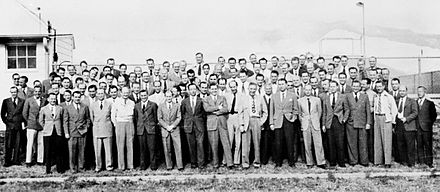Operation Paperclip was a secret operation to bring German scientists and engineers to the United States. In 1943, following the Battle of Stalingrad and the failure of Operation Barbarossa, Germany began to recall scientists from the front lines, and to begin preparing for a longer war by developing new weapons and production methods. During this recall, the Osenberg List was formed, consisting of the names of these scientists. The list was found in a toilet in 1945, and handed over to the Americans. The original plan was to interview only rocket scientists and attempt to persuade them to come to the US. Following a telegram that described the effort as "important for [the] Pacific war", "Operation Overcast" was launched, which was later to be renamed "Operation Paperclip".
Operation Paperclip was formally approved in 1946 by President Truman, and continued until as late as 1959. As one might guess, it was not without its controversy. Most scientists brought as part of the operation were members of the Nazi party, but a few were specially investigated for their more active involvement. Arthur Rudolph, a key rocket engineer, was investigated for war crimes in 1984 and agreed to leave the United States and renounce his citizenship in order to not be prosecuted. Hubertus Strughold, who was considered the "Father of Space Medicine" for his work on the physical and psychological effects of spaceflight on humans, was the subject of three investigations by the US government, and following his death it was confirmed that he was involved in human experimentation in Dachau.
Perhaps the most famous engineer brought to the US by Operation Paperclip was Wernher von Braun. Von Braun is credited as the inventor of the V-2 rocket and was one of the most prominent figures in early spaceflight. Following his move to the United States, he worked as a rocket scientists for NASA, helping design the first American rockets to go into space. He also served as the chief architect of the Saturn V rocket, which launched the Apollo missions.

Sources:
http://www.operationpaperclip.info/
https://www.cia.gov/library/center-for-the-study-of-intelligence/csi-publications/csi-studies/studies/vol-58-no-3/operation-paperclip-the-secret-intelligence-program-to-bring-nazi-scientists-to-america.html
http://www.jewishvirtuallibrary.org/operation-paperclip
http://www.biography.com/people/wernher-von-braun-9224912
Good post that expertly details the importance of Operation Paperclip, as without it we may have struggled in the Cold War arms race. The V-2 rocket though successful, was a rare instance, as numerous rocket and missile tests failed due to combustion. Do you think that the V-2 rocket laid the founding steps for space exploration?
ReplyDeleteFor more information on the Saturn V Rocket:
https://www.nasa.gov/audience/forstudents/5-8/features/nasa-knows/what-was-the-saturn-v-58.html